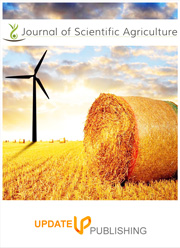Maruca vitrata (Fabricius) [Lepidoptera: Pyralidae] larval population dynamics as affected by intra-row spacing, sowing dates and biopesticides on cowpea
DOI:
https://doi.org/10.25081/jsa.2017.v1.887Keywords:
Sowing dates; intra-row spacing; biopesticides; damage; Maruca vitrataAbstract
The objective of the research was to test the effect of sowing dates, intra-row spacing and biopesticides on the larval population dynamics of M. vitrata in Samaru, Nigeria. The experiment was laid out with biopesticides (B0; control, B1; Neem seeds kernel extract (NKE), B2; Maruca vitrata Multi-nucleopolyhedrosis virus (MaviMNPV) suspension and B3; Cyper diforce (30 g cypermethrin + 250 g dimethoate). The result at 10 WAS showed that varying sowing dates to SD3 significantly (P=.01) reduced mean population of M. vitrata larva in sampled flowers in all the years and the combine. MaviMNPV was effective in reducing pod borer populations (7.22, 6.11 and 6.67) better than NKE (10.19, 5.74 and 7.96) and Cyper diforce (7.41, 8.89 and 8.15). The control significantly recorded the highest mean (11.67, 12.59 and 12.13) population in all the years and the combined. Similarly, varying sowing dates to SD3 significantly reduced mean population (5.56, 5.00 and 5.28) of M. vitrata in cowpea pods sampled 10 WAS better than SD1 and SD2. Statistically similar effect of biopesticides was observed on mean population of M. vitrata, however, the control recorded the highest mean (22.59 and 13.89) in 2015 cropping season and the combined. High cowpea grain yield was obtained in SD2 (337.85, 689.10 and 800.66 kg ha-1) even though statistically similar with SD3 (244.89, 618.10 and 639.68 kg ha-1). Cyper diforce treated plots gave the highest yield of 394.56, 887.69 and 976.51 kg ha-1 during 2015 and 2016 cropping seasons and combine but was statistically at far (P=.01) with NKE and MaviMNPV. The interaction of SD2 and Cyper diforce gave the highest grain yield. The effect of sowing at SD2 and insecticide spray will give a better control of M. vitrata for an increased yield of cowpea in the study area.



 .
.